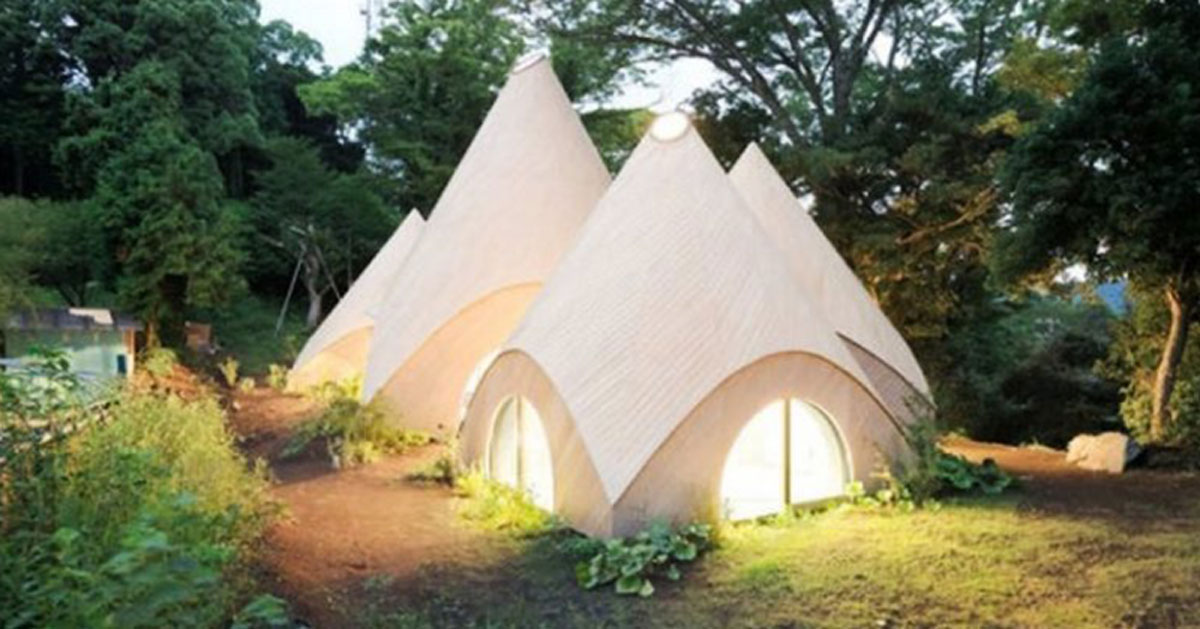Two women in Japan have moved into a private retirement home with hopes of using it to serve the elderly people in their community [1].The enchanting residence is made up of five small hut-like structures that join together to become a single house. Designed by Tokyo-based architect Issei Suma at the request of his mother, Nobuko Suma and her friend Sachiko Fujioka, it was given the name “Jikka”, or “parent’s house” [2].
Jikka Is A Place for Everyone
Nobuko, a social worker, and Sachiko, a cook, worked for ten years together in the welfare sector in Tokyo, preparing and delivering meals to the elderly. Worried that in the future someone would have to take care of them, they wanted to build a space where they could live out there days comfortably [2].
The home is located in Shizuoka, home to Mount Fuji and world-renowned for its tea production. Since the 1980s, it has been a popular destination for people looking for a retreat from their city lives in Tokyo, and has more recently become a popular retirement destination for baby boomers [2].
Built with retirement in mind, there are no stairs in the home, and there is a spiral-shaped bath that was designed for wheelchair access [2].
“I came up with the spiral shape which enables you to use a wheelchair and go down it. At the same time, it’s a great pool for kids and it’s going to be a great jacuzzi for couples, too. Explained Suma.
“That’s my idea of universal design — it’s something that makes every generation happy.” [2]
Serving the Community
The two women may have moved into their retirement home, but they have not stopped working just yet. The residence includes extensive cooking facilities which has allowed them to run a food delivery service for the elderly for the last two years. Nobuko spends her days baking cakes and breads, while Fujioka dedicates her time to cooking meals [2].
Their hope is that one day they will be able to open their home up to the community.
“Perhaps 10 or so years from now, the elderly could stay here to be cared for,” Nobuko says [2].
An Aging Population
Services like the ones Nobuko and Fujioka are providing are needed in Tokyo and Japan in general. Population data from 2018 showed that seniors account for a record 28.4 percent of Japan’s population [3]. There are 2.31 million people in Japan who are older than ninety, and 71 thousand people who are at least one hundred years old [3]. Not only is Japan known for having the oldest population in the world, but also for the way they treat their senior citizens. There is a powerful sense of obligation in Japan to take care of the older member of their society, as is demonstrated by Nobuko and Fujioka’s work [4]. It should not come as a surprise, then, that Japan has one of the most comprehensive social care systems for the elderly in the world – one that is designed around reducing the burden of care for families [4].
How Does Japan Care For The Elderly?
When Japanese citizens reach the age of 65, they can apply to their local government to take a comprehensive test to evaluate their needs. A care manager will then give them guidance as to how their needs can best be met, based on the budget they’ve been given and the types of services available in their area. Care is predominantly community-based, and includes a range of organizations in the public, not-for-profit, and private sector, that are usually small and embedded in the community [4].
The emphasis in Japan is on community care, so there are actually very few residential homes for the elderly, which is in part what prompted Nobuko and Fujioka to build their little oasis [4].
A Jikka Oasis for Seniors
The two friends wanted something simple and down-to-earth for their new abode, and this inspired Issei, and made him think about the Stone Age homes that you can find all over Japan.
“That to me is un-embellished living,” he explained [2].
Jikka has a back-to-nature feel, and the shape of the home mimics the mountain range that surrounds it. The high ceilings help to create an abundance of natural light, and are a symbol of old age for Issei [2].
“In that sense, it might make sense that a person that might move out here and live here in a primitive hut — by the end of their life they can somehow grow up to the roof to the ceiling to the sky.” [2]
As Japan’s population ages, the two women hope to help care for these people – and for themselves- with their home, to offer a serene location to enjoy their final years in peace and tranquility.
Keep Reading: 5 Countries Where You Can Retire by the Beach for Less Than $1,500 a Month
- ‘This Japanese Forest Home Is Cuter Than Any Hobbit House’ House Beautiful. Published September 23, 2016.
- ‘Jikka, the fairy tale dwarf home for Japan’s seniors’ CNN. Published December 9, 2018
- ‘Elderly citizens accounted for record 28.4% of Japan’s population in 2018, data show’ Japan Times Published September 15, 2016.
- ‘Japan has the world’s oldest population – this is what we can learn from their social care model’ Independent Iza Kavedzija. Published 31 May 2018

